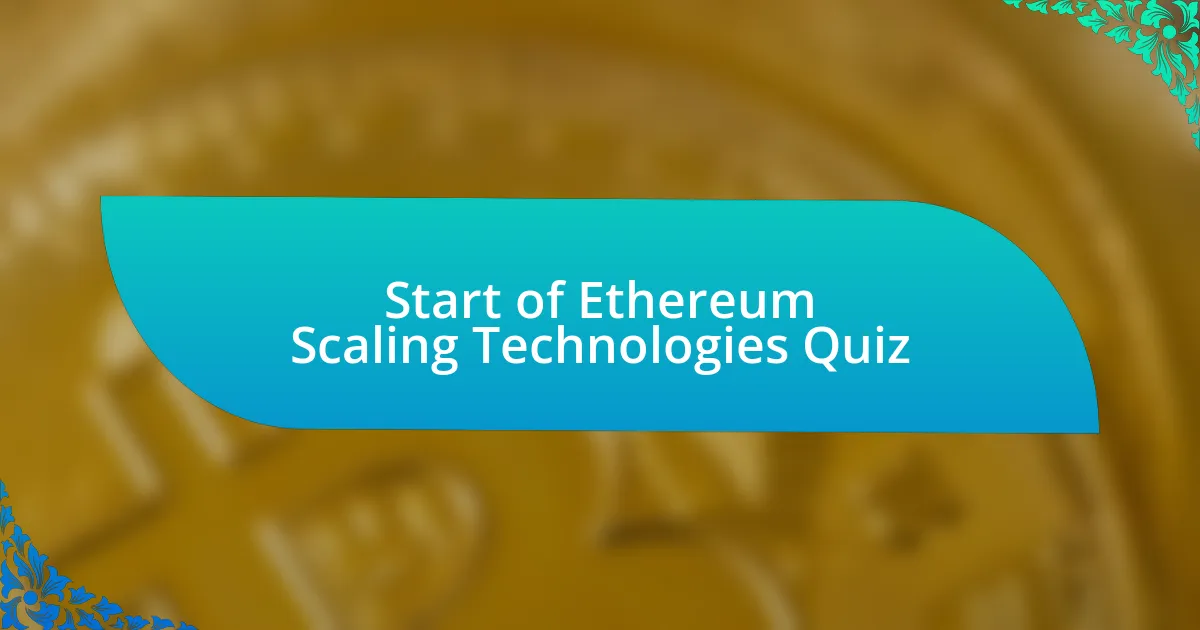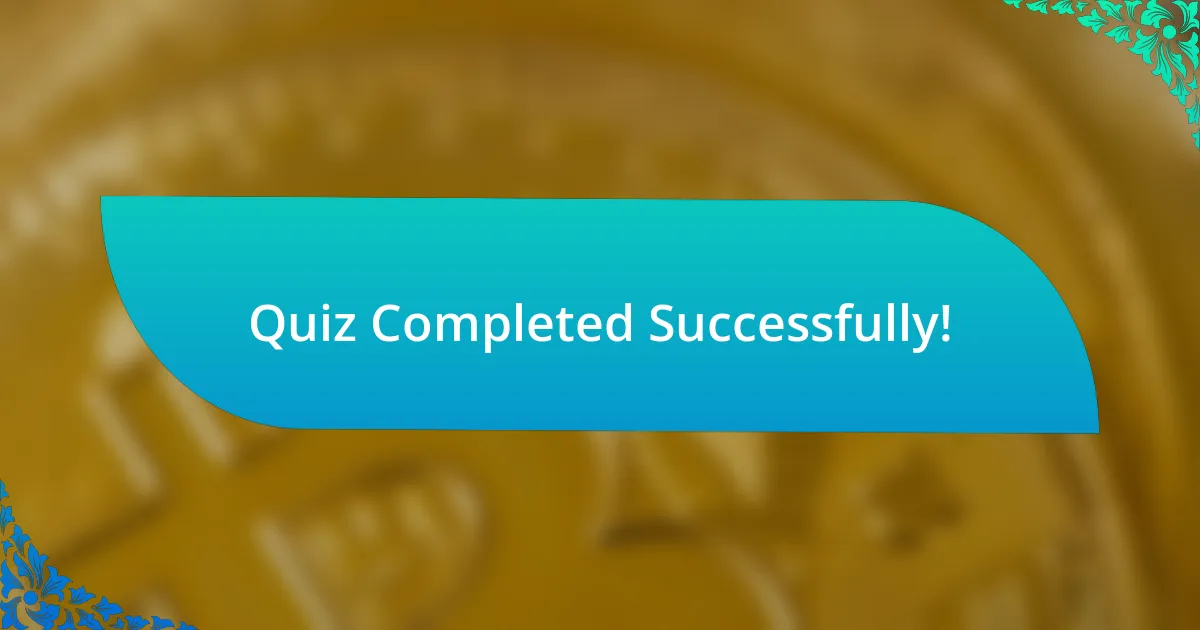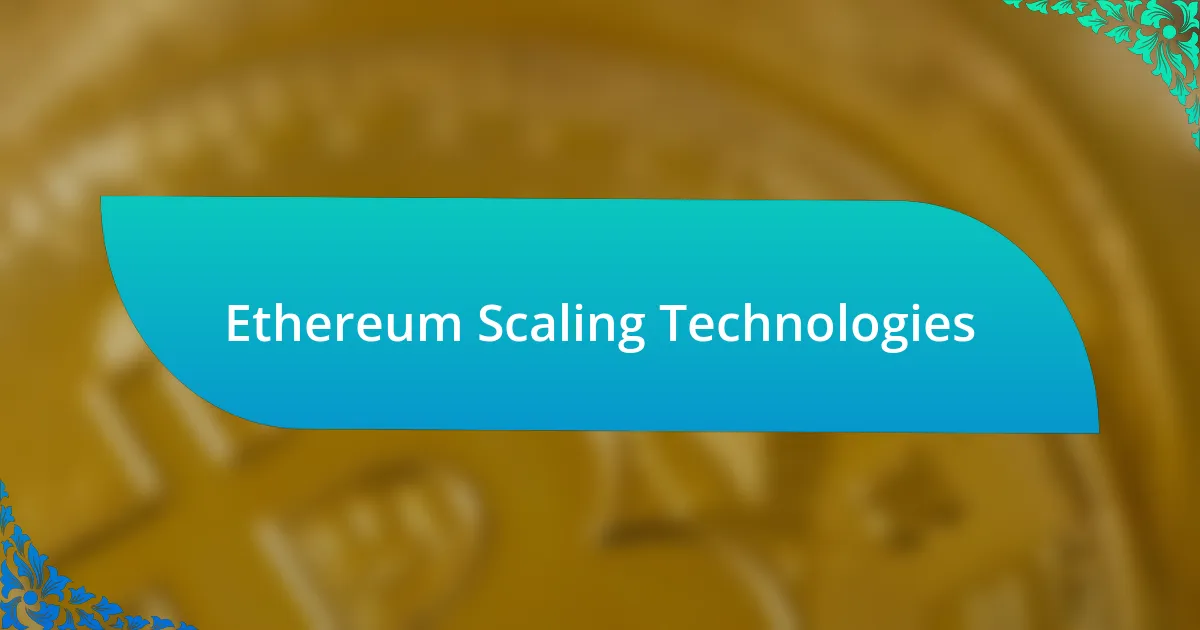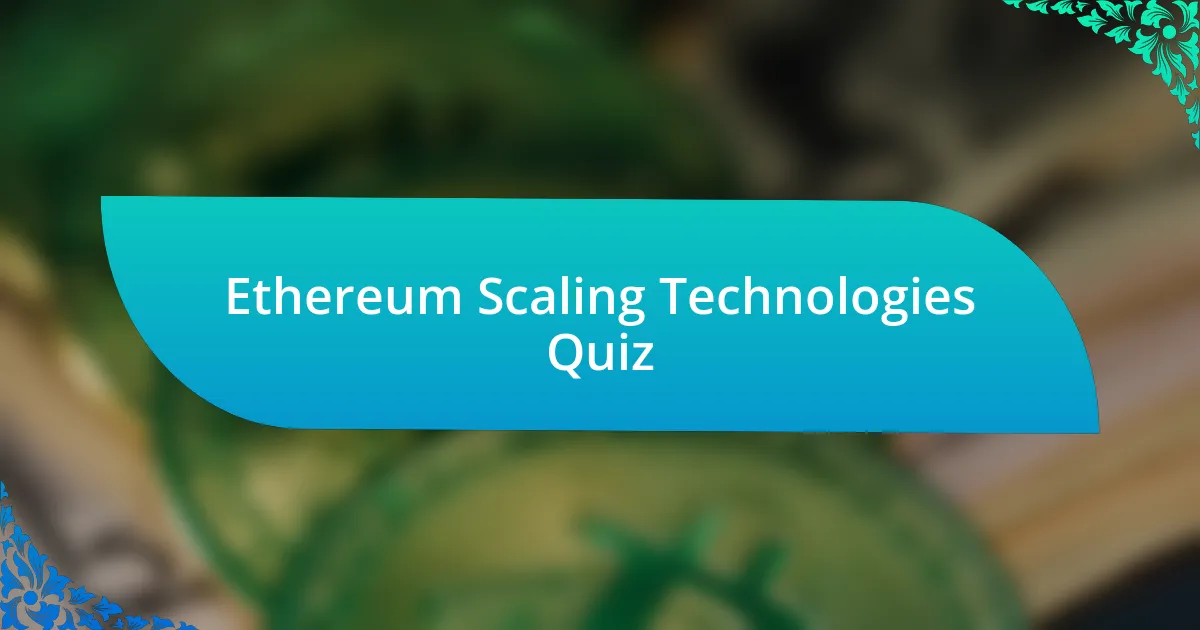
Start of Ethereum Scaling Technologies Quiz
1. What is the primary goal of Ethereum scaling technologies?
- To reduce the overall number of Ethereum tokens.
- To enhance user interface for Ethereum applications.
- To increase transaction speed and transaction throughput.
- To improve Ethereum`s mining efficiency.
2. What is the main difference between on-chain and off-chain scaling?
- On-chain scaling is related to transaction fees, off-chain scaling has no fees.
- On-chain scaling occurs only within a single blockchain, off-chain scaling uses multiple blockchains.
- On-chain scaling is slower, off-chain scaling is always faster.
- On-chain scaling requires protocol changes, off-chain scaling utilizes secondary networks.
3. What is the purpose of sharding in Ethereum?
- Sharding is used to increase the number of validators.
- Sharding is a method to add new cryptocurrencies.
- Sharding involves splitting the blockchain to enhance scalability.
- Sharding helps in reducing transaction fees for all users.
4. Which consensus algorithm does Ethereum currently use?
- Delegated Proof-of-Stake (DPoS)
- Byzantine Fault Tolerance (BFT)
- Proof-of-Stake (PoS)
- Proof-of-Work (PoW)
5. What is the Ethereum Virtual Machine (EVM)?
- A database for storing smart contracts.
- A physical server hosting Ethereum transactions.
- A programming language for Ethereum developers.
- A decentralized virtual machine executing scripts on a public network.
6. What is the value token for Ethereum?
- Ripple (XRP)
- Litecoin (LTC)
- Bitcoin (BTC)
- Ether (ETH)
7. What is the smallest unit in the Ether cryptocurrency?
- Ether
- Wei
- Gwei
- Bit
8. How many Wei are in one Ether?
- 1 Ether = 10^15 Wei
- 1 Ether = 10^12 Wei
- 1 Ether = 10^18 Wei
- 1 Ether = 10^9 Wei
9. What happens when the gas runs out without the transaction being complete?
- No transactions are processed and network halts.
- All transactions are reversed and miner is compensated.
- Transaction is completed, and gas is lost entirely.
- All gas fees are refunded, and process resumes.
10. What is the difference between Bitcoin and Ethereum in checking the latest state?
- Bitcoin verifies block rewards, while Ethereum checks token contracts.
- Bitcoin checks the entire blockchain, while Ethereum checks block headers.
- Bitcoin checks unspent transaction outputs (UTXO), while Ethereum checks account states.
- Bitcoin tracks miner addresses, while Ethereum assesses transaction fees.
11. What are the benefits of using Layer 2 solutions?
- Decreased network security and higher transaction costs.
- Higher transaction throughput, reduced transaction costs, faster transaction finality, and improved privacy.
- Slower transaction speeds and limited scalability options.
- Inability to support decentralized applications effectively.
12. What are the two types of rollups in Layer 2 solutions?
- Merge Rollups and Standard Rollups
- Optimistic Rollups and Zero-Knowledge (zk) Rollups
- On-Chain Rollups and Sidechain Rollups
- Direct Rollups and Adaptive Rollups
13. How do Optimistic Rollups work?
- They gather all transactions on-chain to verify using multiple nodes synchronously.
- They utilize cryptographic proofs to ensure data security and integrity for each transaction.
- They eliminate the need for any external validation, relying solely on the main blockchain.
- They use economic incentives and game theory for validating transactions, relying on external validators to check merkle roots before updating the state.
14. How do Zero-Knowledge (zk) Rollups work?
- They rely solely on on-chain data to validate transactions without any external verification.
- They employ cryptographic proofs for security and privacy, offloading data storage off-chain to reduce processing power and gas fees.
- They use economic penalties for invalid transactions and do not allow off-chain data.
- They evaluate every transaction on the main chain to ensure maximum security and transparency.
15. What is Plasma in the context of Ethereum Layer 2 solutions?
- Plasma creates a single blockchain for all transactions without any verification.
- Plasma uses child or secondary blockchains to assist the main chain in verification.
- Plasma involves merging multiple cryptocurrencies into one.
- Plasma is a method for increasing transaction fees on the main chain.
16. What is Starkware in the context of Ethereum Layer 2 solutions?
- Starkware is a provider of Ethereum layer 2 scaling solutions, including StarkNet, StarkEx, and Cairo, which use STARKs for scaling dApps.
- Starkware is a blockchain protocol designed for identity verification and security.
- Starkware is a decentralized exchange built on Ethereum for trading NFTs.
- Starkware is a cryptocurrency wallet focused on asset storage and management.
17. What is Cairo in the context of Starkware?
- Cairo is a NFT marketplace developed by Starkware.
- Cairo is Starkware`s Turing-complete language.
- Cairo is a blockchain protocol for Bitcoin.
- Cairo is a consensus algorithm used in Ethereum.
18. What is Optimism in the context of Ethereum Layer 2 solutions?
- Optimism is a consensus algorithm for Ethereum.
- Optimism is an ERC-20 token on Ethereum.
- Optimism is a type of sidechain for Bitcoin.
- Optimism is an EVM compatible optimistic rollup chain.
19. What is Arbitrum in the context of Ethereum Layer 2 solutions?
- Arbitrum is a layer 2 solution designed to boost the speed and scalability of Ethereum smart contracts, adding additional privacy features.
- Arbitrum is a decentralized exchange for trading Ethereum tokens.
- Arbitrum is a consensus algorithm designed to replace Proof-of-Stake on Ethereum.
- Arbitrum is a new cryptocurrency that operates independently from Ethereum.
20. What are the different technologies used by Polygon to enhance Ethereum’s scalability?
- Ethereum Classic, Bitcoin, Litecoin
- Ethereum 2.0, Ripple, Stellar
- Polygon PoS, Polygon Miden, Polygon Hermez, Polygon Avail, Polygon Zero, and Polygon Nightfall
- Cardano, Solana, Chainlink
21. What is Polygon PoS?
- Polygon PoS is an EVM-compatible sidechain.
- Polygon PoS is a centralized exchange platform.
- Polygon PoS is an NFT marketplace.
- Polygon PoS is a Bitcoin fork.
22. What is Polygon Miden?
- Polygon Miden is a decentralized exchange platform.
- Polygon Miden is a type of smart contract language.
- Polygon Miden is a zk-rollup based on Starkware.
- Polygon Miden is a Layer 1 blockchain.
23. What is Polygon Hermez?
- Polygon Hermez is an open-source zero-knowledge rollup.
- Polygon Hermez is a decentralized exchange.
- Polygon Hermez is a mining algorithm.
- Polygon Hermez is a layer 1 blockchain.
24. What is Polygon Avail?
- Polygon Avail is a DeFi protocol for lending and borrowing tokens.
- Polygon Avail is a Bitcoin wallet for storing Ether.
- Polygon Avail is a standalone layer-2 chain with a data availability focus.
- Polygon Avail is a GameFi platform for blockchain-based games.
25. What is Polygon Zero?
- A zk-rollup chain
- A payment processing platform
- A sidechain technology
- A smart contract layer
26. What is Polygon Nightfall?
- Polygon Nightfall is a privacy-focused rollup chain.
- Polygon Nightfall is a blockchain game.
- Polygon Nightfall is a decentralized exchange.
- Polygon Nightfall is a Bitcoin wallet.
27. What is the role of state channels in Layer 2 solutions?
- State channels require all transactions to be processed on-chain for security.
- State channels are used to exchange NFTs directly on the main chain.
- State channels store all data permanently on the main blockchain.
- State channels allow off-chain transactions by locking funds in a multisignature contract.
28. What are the limitations of state channels?
- State channels can operate independently without any online presence.
- State channels require participants to be online and are limited to pre-defined participant sets.
- State channels cannot handle smart contracts at all.
- State channels are unlimited in the number of participants allowed.
29. What are the benefits of using Zero-Knowledge (zk) Rollups?
- They require all data to be stored on-chain, leading to higher gas fees and slower performance.
- They perform better than layer 1 due to off-chain storage of data, saving large amounts of processing power and reducing gas fees.
- They increase transaction latency, which slows down processing times and validity.
- They do not affect transaction costs and mainly enhance the user interface of applications.
30. What are the benefits of using Optimistic Rollups?
- They only allow for simple transactions without smart contracts.
- They can support smart contracts in a similar way to the underlying smart contracts blockchain.
- They guarantee immediate transaction confirmation without any waiting time.
- They significantly increase block size to improve speeds and throughput.

Quiz Completed Successfully!
Congratulations on completing the quiz on Ethereum Scaling Technologies! You’ve taken a significant step in enhancing your understanding of this vital area in blockchain technology. Through this quiz, you have likely learned about different scaling solutions such as Layer 2 solutions, sharding, and various protocols that aim to improve Ethereum’s transaction speed and efficiency.
It’s essential to recognize the importance of these technologies in addressing Ethereum’s scalability challenges. By exploring concepts like Optimistic Rollups and zk-Rollups, you’ve gained insights into how these mechanisms can help reduce congestion on the network. This knowledge is not only helpful for understanding Ethereum’s future but also valuable in the broader context of cryptocurrency developments.
Now that you’ve built a foundational understanding of Ethereum scaling, we invite you to delve deeper! Check out the next section on this page dedicated to Ethereum Scaling Technologies. There, you will find more detailed information, practical applications, and the latest updates in the field. Expanding your knowledge will further enhance your insights into this rapidly evolving technology.

Ethereum Scaling Technologies
Introduction to Ethereum Scaling Technologies
Ethereum scaling technologies refer to solutions designed to enhance the Ethereum network’s capacity and performance, allowing it to handle more transactions per second. Despite its popularity, the Ethereum blockchain faces congestion during peak usage, leading to slower transactions and higher fees. Scaling technologies aim to address these issues, ensuring the network remains efficient and accessible as adoption grows.
Layer 1 Solutions for Ethereum Scaling
Layer 1 solutions involve changes to the Ethereum protocol itself to increase throughput. These include improving consensus mechanisms, such as implementing Ethereum 2.0, which transitions from Proof of Work to Proof of Stake. This shift is projected to improve network scalability significantly, potentially enabling thousands of transactions per second compared to the current limitations.
Layer 2 Solutions: Rollups and Sidechains
Layer 2 solutions, including rollups and sidechains, operate on top of the Ethereum blockchain to enhance scalability. Rollups process transactions outside the main chain and then bundle them together, reducing the load on the Ethereum network. Sidechains are separate blockchains that run parallel to Ethereum, allowing transaction handling independently while still being linked to the primary network. Both solutions help decrease congestion and fees on Ethereum.
State Channels as a Scaling Technique
State channels are a technique that enables off-chain transactions between users without immediate on-chain settlement. Participants establish a private channel to conduct multiple transactions, only recording the final state on the blockchain. This dramatically reduces the number of on-chain transactions, alleviating congestion and lowering costs, making it efficient for microtransactions and frequent interactions.
The Role of zk-SNARKs in Ethereum Scaling
zk-SNARKs, or zero-knowledge succinct non-interactive arguments of knowledge, are cryptographic proofs that allow one party to prove possession of certain information without revealing the information itself. In Ethereum scaling, zk-SNARKs help compress transaction data, increasing throughput by enabling more transactions to be processed and verified off-chain while maintaining privacy and security. This technology can potentially revolutionize how data is handled on the Ethereum network.
What are Ethereum Scaling Technologies?
Ethereum scaling technologies are solutions designed to improve the transaction throughput and efficiency of the Ethereum blockchain. They aim to reduce congestion, lower transaction fees, and enhance user experience. Examples include Layer 2 solutions like Optimistic Rollups and zk-Rollups, which process transactions off the main Ethereum chain and then bundle them for final settlement. These methods can significantly increase transaction capacity while maintaining security and decentralization.
How do Ethereum Scaling Technologies work?
Ethereum scaling technologies function by offloading some transaction processing from the main Ethereum blockchain. Layer 2 solutions like Rollups aggregate multiple transactions into a single one, thereby lowering the amount of data that needs to be confirmed on the main chain. Other methods, such as sharding, segment the blockchain into smaller pieces to allow for parallel processing of transactions, effectively increasing the network’s capacity.
Where are Ethereum Scaling Technologies primarily implemented?
Ethereum scaling technologies are primarily implemented on the Ethereum network itself. They are used by decentralized applications (dApps) and protocols that seek to improve their transaction speeds and reduce costs. Layer 2 solutions like Polygon, Arbitrum, and Optimism are built on top of the Ethereum blockchain to facilitate faster and cheaper transactions while leveraging Ethereum’s security properties.
When were Ethereum Scaling Technologies introduced?
Ethereum scaling technologies began gaining prominence after the Ethereum network faced significant congestion and high gas fees during periods of high demand, particularly in 2017 and 2020. The development of Layer 2 solutions started around 2019, with projects like zkSync and Optimistic Rollups emerging to address these challenges. The continued evolution of these technologies is driven by Ethereum’s transition towards Ethereum 2.0 and its implementation of proof-of-stake.
Who are the key players in Ethereum Scaling Technologies?
The key players in Ethereum scaling technologies include development teams and organizations focused on Layer 2 solutions and infrastructure. Notable contributors are Optimism, the team behind Optimistic Rollups; Matter Labs, which develops zkSync; and the Polygon network, which provides multiple scaling solutions. These teams work to innovate and deploy technologies that enhance Ethereum’s capability and usability.

